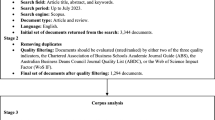Abstract
The balanced scorecard (BSC) is a multi-attribute evaluation concept that highlights the importance of non-financial attributes. By incorporating a wider set of non-financial attributes into the measurement system of a firm, the BSC captures not only a firm's current performance, but also the drivers of its future performance. Although there is an abundance of literature on the BSC framework, there is a scarcity of literature on how the framework should be properly implemented. In this paper, we use the analytic hierarchy process (AHP) and its variant the analytic network process (ANP) to facilitate the implementation of the BSC. We show that the AHP and the ANP can be tailor-made for specific situations and can be used to overcome some of the traditional problems of BSC implementation, such as the dependency relationship between measures and the use of subjective versus objective measures. Numerical examples are included throughout.






Similar content being viewed by others
References
Baiman S and Rajan MV (1995). The informational disadvantages of discretionary bonus schemes. Acc Rev 70: 557–579.
Banker R and Datar S (1989). Sensitivity, precision and linear aggregation of signals for performance evaluation. J Acc Res 27: 21–39.
Belton V and Gear T (1983). On a short-coming of Saaty's method of analytic hierarchies. OMEGA 11: 228–230.
Brancato CK (1995). New performance measures—a research report. Report Number 1118-95-RR, Conference Board, New York, NY.
Chan YL and Lynn BE (1991). Performance evaluation and AHP. J Mngt Acc Res 3: 57–87.
Dyson RG (2000). Strategy, performance and operational research. J Opl Res Soc 51: 5–11.
Eccles RG and Pyburn PJ (1992). Creating a comprehensive system to measure performance. Mngt Acc 74: 41–44.
Harker PT and Vargas LG (1990). Remarks on the analytic hierarchy process—Reply. Mngt Sci 36 (3): 269–273.
Ittner C and Larcker DF (1998). Innovations in performance measurement: trends and research implications. J Mngt Acc Res 10: 205–238.
Kaplan RS and Atkinson AA (1998). Advanced Management Accounting, 3rd edn. Prentice-Hall: NJ.
Kaplan RS and Norton DP (1992). The balanced scorecard—measures that drive performance. Harvard Bus Rev 70: 71–79.
Kaplan RS and Norton DP (1996). The Balanced Scorecard. Harvard Business Press: Boston, MA.
Lawson R, Stratton W and Hatch T (2003). Winning ways: implementation strategies balanced scorecard success. CMA Mngt 77: 26–28.
Leung LC and Cao D (2001). On the efficacy of modeling multi-attribute decision problems using AHP and Sinarchy. Eur J Opl Res 132: 39–49.
Leung LC, Hui YV and Zheng M (2003). Analysis of compatibility between interdependent matrices in ANP. J Opl Res Soc 54: 758–768.
Liberatore MJ and Miller T (1998). A framework for integrating activity-based costing and the balanced scorecard into the logistics strategy development and monitoring process. J Bus Logistics 19: 131–154.
Maskell BH (1992). Performance measurement for world class manufacturing. Corporate Controller 4: 44–49.
Rangone A (1996). An analytical hierarchy process framework for comparing the overall performance of manufacturing departments. Int J Ops Prod Mngt 16: 104–119.
Saaty TL (1980). The Analytic Hierarchy Process. McGraw-Hill: New York.
Saaty TL (1996). The Analytic Network Process. RWS Publications: Pittsburgh.
Simons R (1999). Performance Measurement & Control Systems for Implementing Strategy. Prentice Hall: NJ.
Smith PC and Goddard M (2002). Performance management and operational research: a marriage made in heaven? J Opl Res Soc 53: 247–255.
Suwignjo P, Bititci US and Carrie AS (2000). Quantitative models for performance measurement system. Int J Prod Econ 64: 231–241.
Acknowledgements
We would like to thank the referees for their thoughtful comments.
Author information
Authors and Affiliations
Corresponding author
Appendix A
Appendix A
Detailed List (Source: Kaplan and Atkinson: Advanced Management Accounting: Chapters 7–12)
-
1)
Financial perspective
-
Sales: annual growth in sales and profits.
-
Cost of sales: extent that it remains flat or decreases each year.
-
Profitability: EVA or return on total capital employed.
-
Prosperity: cash flows.
-
Company growth versus industry growth.
-
Ratio of international sales to total sales.
-
New product: gross profit/growth from new products.
-
Industry leadership: market share.
-
-
2)
Customer perspective
-
Market share for target customer segment.
-
Customer retention/percentage of growth with existing customers.
-
Customer acquisition: number of new customers/total sales to new customers/actual new customers divided by prospective inquiries.
-
Customer satisfaction (via satisfaction surveys).
-
Customer profitability (via accounting analyses).
-
Customer lead time (on-time delivery).
-
Quality: parts-per-million (PPM) defect rates, reworks, percentage of returns.
-
-
3)
Internal business perspective
-
Manufacturing cycle effectiveness=processing time/throughput time.
-
Cost of quality comparison.
-
Low cost producer: unit cost versus competitors’ unit cost.
-
Reduce inventory: inventory as percentage of sales.
-
Output per hour/plant utilization.
-
Safety incident index.
-
-
4)
Learning and growth
-
Innovation measures
-
Breakeven time: the time from the beginning of product development work until the product has been introduced.
-
Rate of new product introduction per quarter.
-
Number of new products with patented technology/ new patents.
-
Annual increase in number of new products per engineer.
-
-
Employee capabilities
-
Employee satisfaction survey.
-
Employee retention: percentage of key staff turnover.
-
Employee productivity: revenue per employee.
-
Salaries compared to the norm in the local area.
-
Percentage of competency deployment matrix filled.
-
Number of promotions from within.
-
Absenteeism rate.
-
-
Rights and permissions
About this article
Cite this article
Leung, L., Lam, K. & Cao, D. Implementing the balanced scorecard using the analytic hierarchy process & the analytic network process. J Oper Res Soc 57, 682–691 (2006). https://doi.org/10.1057/palgrave.jors.2602040
Received:
Accepted:
Published:
Issue Date:
DOI: https://doi.org/10.1057/palgrave.jors.2602040




